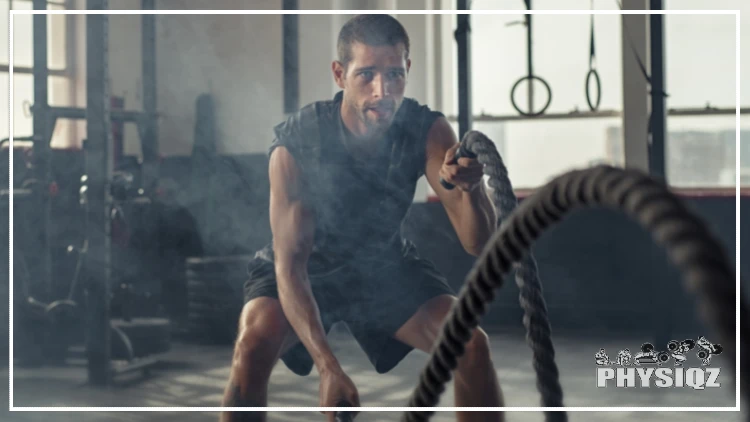
When using the battle rope, muscles worked include several muscles in the arms, back and shoulders but many other lesser known muscle groups such as the legs and core are being used too.1
That being said, there are many more muscles within each muscle group listed above so we’ll cover the technical and laymen term for, every muscles function and provide a picture so you know exactly where the muscle is.
Additionally, we’ll cover whether or not battle ropes are good for weight loss and toning, how many calories battle ropes burn, the apparent and hidden muscle building benefits of battle ropes, how to use the ropes with perfect form, battle rope before and after pictures, and a full on workout program to take the guesswork out of it.
So before diving into the battle rope workout program that can both shed off pounds and tone your entire body, check out which muscles will be sore so you know what you’re getting into.
Battle Rope: Muscles Worked (Location, Function, & Role in Battle Ropes)
The battle ropes offer a full-body workout, working out the arms, legs, and abs. Additionally, because of all the different variations of how one can use the ropes, it’s possible to specifically target a particular muscle.
The battle rope has been shown to improve the body’s upper and lower body power and endurance.2
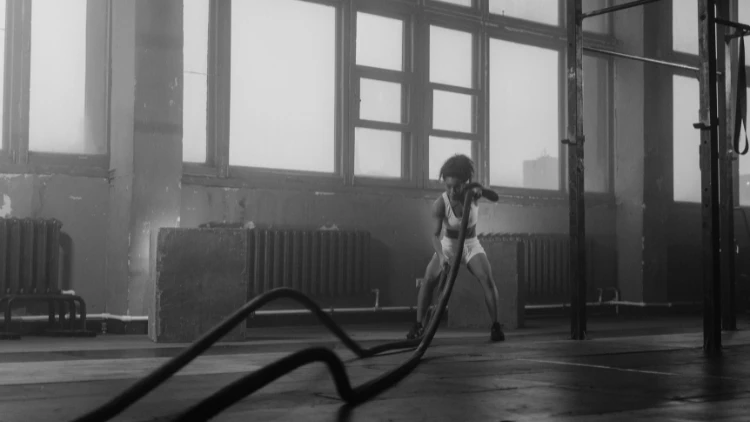
Source: Tima Miroshnichenko via Canva.com3
When questioning what battle rope muscles worked, some people may think the battle ropes mainly work the upper body but the lower is also engaged while using the battle ropes. The lower body is extremely important in stabilizing and balancing the exerciser.
Additionally, it’s possible to incorporate side, front, and back lunges while using the battle ropes to further work out the legs.
Quads, Hamstrings, & Glutes

Source: janulla via Canva.com
The quads are the front part of the upper leg and they’re one of the largest muscles in the body. A person’s quads are important in a variety of movements such as running, jumping, and walking, and are responsible for flexing the leg.
These muscles are activated while squatting or leaning back while using the battle ropes.
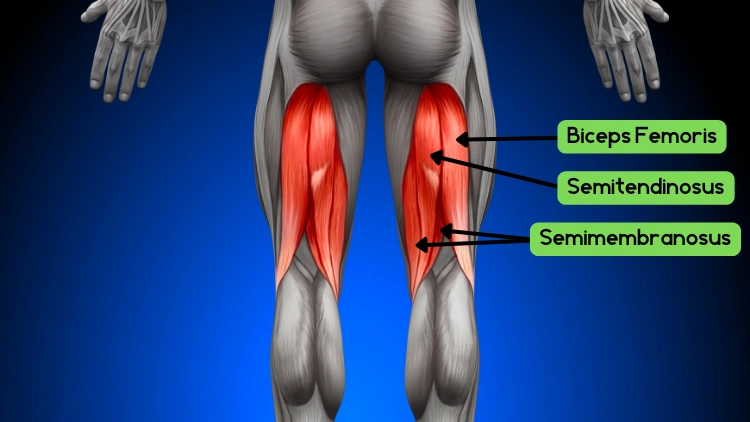
Source: decade3d via Canva.com4
The hamstrings are the back part of the upper leg between the knee and hip and they are engaged while flexing the leg at the knee joint and are also very important in running, walking, and jumping. Additionally, having strong hamstrings is crucial as that can help prevent knee injuries.
Back squats are also an excellent way to target both the hamstrings and quads.
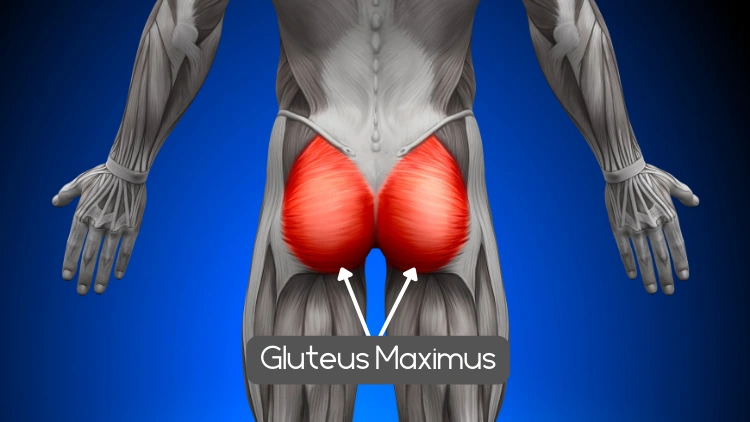
Source: decade3d via Canva.com5
The glutes, informally known as the butt muscles are activated while squatting and sitting in a strong, squat position while using the battle ropes. These muscles are helpful in turning the hips in and out.
Having strong glutes can also help limit lower back and knee pain and injury. There are also various exercises that can be done to strengthen the knee after injury.
Upper Back
The back muscles or the rhomboids are found between the shoulder blade and spine. One could engage these muscles while pressing their shoulder blades together.
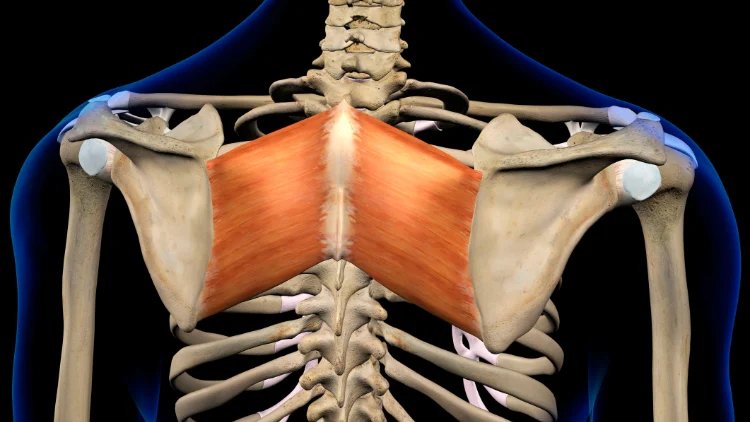
Source: Hank Grebe via Canva.com6
The rhomboids are responsible for rotating and moving the shoulder blade also known as the scapula.
The battle rope back workout is effective. These back muscles are activated with the up-and-down motion of swinging the battle ropes.
The rhomboids aid in moving the scapula and helping to stabilize the shoulder.
Chest
The chest muscles, commonly known as the pecs are composed of the pectoralis major and minor, with the pectoralis major being the largest. These muscles are responsible for moving the arms across the body and pressing the hands away from the body.
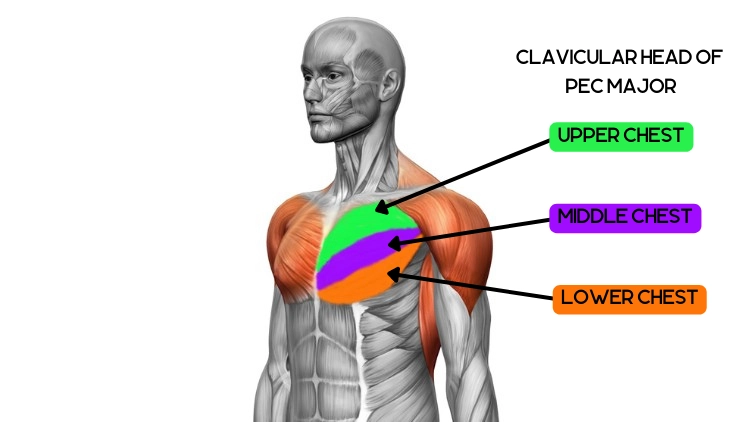
Source: Science Photo Library via Canva.com7
The pecs are engaged while using the battle ropes while moving the ropes side to side or up and down.
Traps
The trapezius or commonly known as the traps are the muscles found from the bottom of the neck, across the shoulders, and to the middle of the back. The traps are vital in turning the head, lifting the shoulders, and rotating the arm.
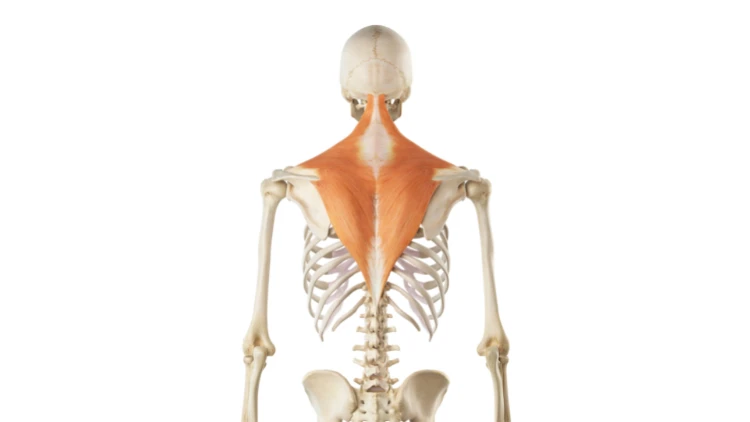
Source: Science Photo Library via Canva.com8
The traps are activated while using the battle rope with every arm rep as the arms move the rope up and down.
Arms – Biceps, Triceps, & Forearms
While the battle ropes do engage the entire body, the arms are the primary targeted muscles while using this piece of equipment.
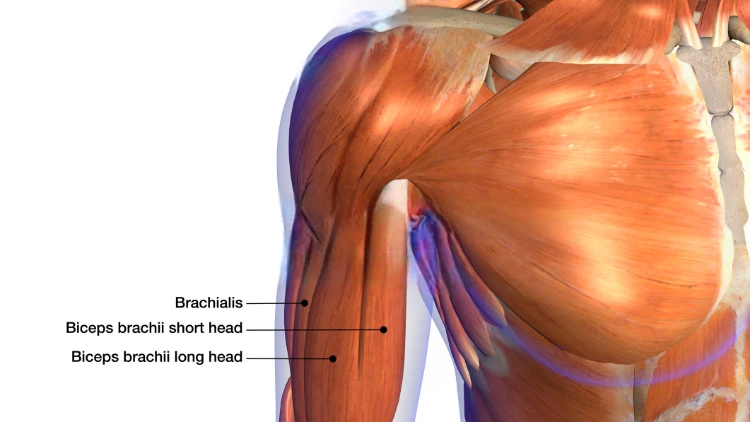
Source: Hank Grebe via Canva.com9
The biceps are the muscles found at the front of one’s arm between the shoulder and elbow. The biceps are responsible for bending the arm and helping lift and move items.
The biceps are engaged while moving the ropes up and are crucial in bending the arm. Having strong biceps is important in carrying and lifting items.
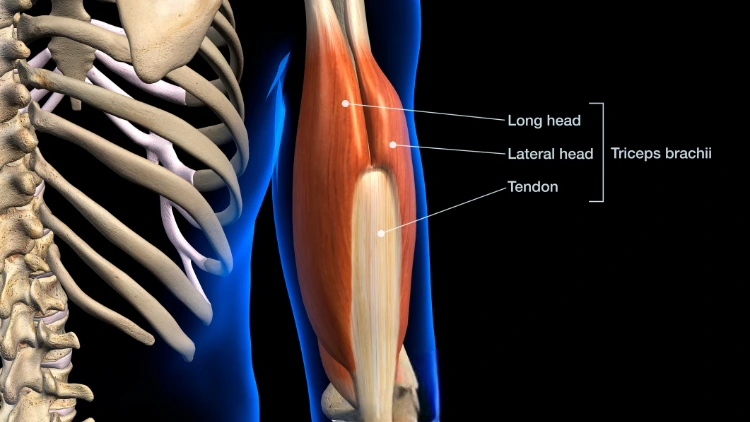
Source: Hank Grebe via Canva.com10
The triceps are the muscles at the back of the arm between the shoulder and elbow. These muscles are responsible for flexing the arm.
Additionally, the triceps are targeted while extending the arm and are activated while using the battle ropes when motioning the ropes down.
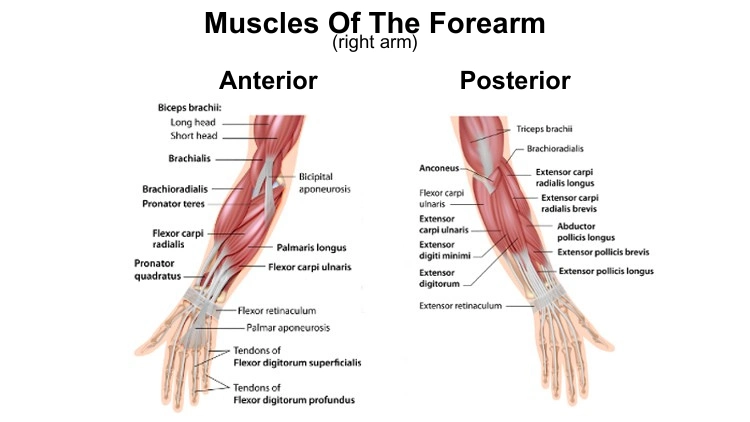
Source: Alila Medical Media on Shutterstock
The forearm is the area between the hands and the elbow. There are 5 muscles under the side of the forearm and 5 on the top.
These muscles in the forearm are responsible for twisting the arm up and down and side to side. Interestingly, the forearms can be challenging to develop, earning them a spot on the list of the hardest muscles to grow.
These muscles are activated through a variety of wrist motions while using the battle ropes.
Core
The core muscles are composed of three different sections, the rectus abdominis, more commonly known as the “6-pack”, the internal and external obliques, or the side muscles. These muscles are responsible for the body’s balance and stability as well as twisting the body to the sides.
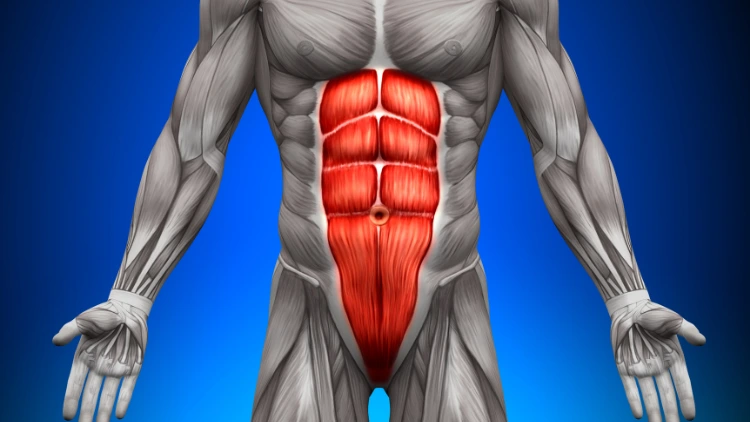
Source: decade3d via Canva.com11
While using the battle ropes one will engage their core muscles to balance as they move the ropes.
Shoulders
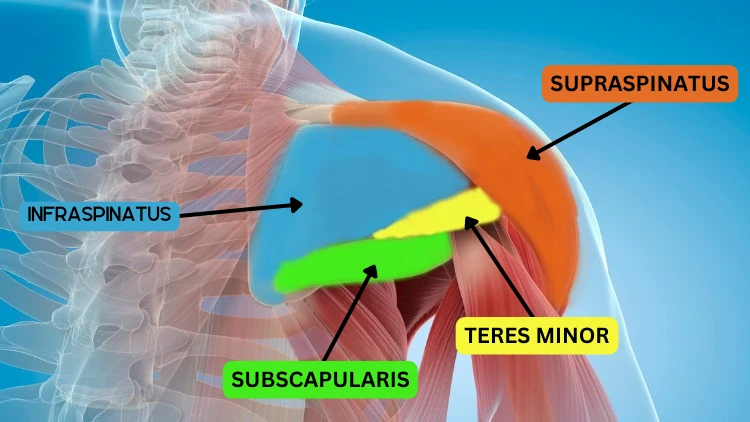
Source: Science Photo Library via Canva.com12
The shoulder muscles are composed of 4 different muscles, the supraspinatus, infraspinatus, teres minor, and subscapularis. These muscles work together and are responsible for helping to stabilize the arm joint and move the arm.
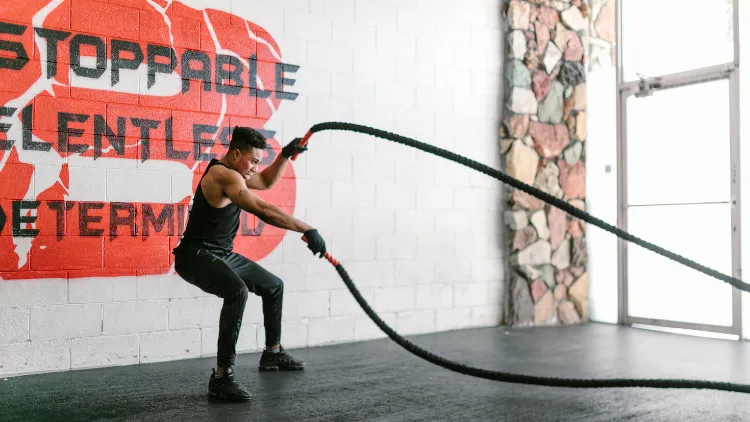
Source: RODNAE Productions from Pexels13
The rope shoulder workout activates these muscles with every rope motion. With the shoulder being such a flexible joint, having strong shoulder muscles is beneficial to support this joint and help prevent injury.
In addition to utilizing battle ropes for shoulder muscle growth, there are other shoulder protocols to enhance strength and mobility.
Is Battle Rope Good for Weight Loss?
The list of muscles worked in a battle rope is extensive therefore, this could be a good exercise for weight loss but there are important things to keep in mind. When pursuing a weight loss journey there are a variety of different methods one can take.
Research has shown that it only takes 10 minutes of using the battle ropes to increase one’s heart rate to have a high-intense workout.14
Additionally, deciding between the duration and intensity of the workout is important as additional research has shown that shorter high-intense workouts may be better than longer durations.15 Also utilizing the battle ropes in a HIIT workout has been shown to increase muscle performance after only 6 weeks.16
That being said, for weight loss it may be best to use the battle ropes for a shorter amount of time at a higher intensity to have a high heart rate cardio and strength-building exercise to help lose weight alongside gain muscle.
How Many Calories Can I Burn Using the Battle Rope?
While the exact number of calories burned will vary based on the exerciser’s body weight, gender, age, duration, and intensity of the exercise, it is possible to burn between 10-15 calories per minute while using the battle ropes.
When compared to other free-weight and body-weight exercises, battle ropes are shown to produce the highest metabolic response.17 This means it produced a higher-intensity cardio workout, which helps the body shift to fat-burning and muscle-building.18
Are Battle Ropes Good for Toning or Building Muscle?
While considering the extensive list of muscles worked in battle rope it is clear to see that the battle ropes are good for toning and building muscle because so many different muscles are targeted. Additionally, the battle ropes offer a low-impact exercise so even those who may have lower body injuries can engage in this exercise.
While battle ropes are excellent for beginners to build muscle, it’s worth noting that due to the need to progressively increase weight over time for sustained muscle growth and to keep getting stronger, they might not be the best choice for experienced weightlifters or exercisers.19
Other exercises such as weight lifting may be a better option because it is not possible to consistently increase the weight of the battle ropes so long-term muscle growth will be more difficult to achieve.
Battle Rope Benefits
One of the most notable benefits of using battle ropes is the ability to have an effective full-body workout that can burn a lot of calories. Battle ropes are a beginner-friendly exercise, making them an excellent addition to a beginner’s guide for those seeking to enhance their beginner hypertrophy program.
Even though with battle rope, muscles worked are the upper and lower body, it also offer a cardio and endurance workout. They can help train power and explosive movements alongside speed and agility.
As a lesser known or hidden benefit, battle ropes can also build muscle in beginners and if the weight of the rope is increased over time with thicker and thicker ropes, then gymgoers can progressively overload (increase the weight over time) as well. Although most use the battle rope for cardio.
Note, if someone is using battle ropes to tone and build muscle, they should also consider sticking to hypertrophy (muscle building) rep ranges as well which in general is 8-20 reps with any less being nearing strength rep ranges and any higher then 20-30+ it’s nearing endurance rep ranges.
Proper Form When Using the Battle Rope
Proper form is crucial when using the battle ropes because it is a piece of equipment that is often used incorrectly.
But to detail battle rope form, keep the following tips in mind:
- Keep the body in an athletic stance with the legs shoulder width apart, the core tight, and the knees slightly bent.
- One rope should be in each hand with palms facing in while holding the ropes at the end.
- It’s important to hold the rope firmly but not too tight as an overly tight grip could result in injury or discomfort over time.
- There should also be a slight bend in hips while keeping a flat and straight back.
- How battle ropes are swung will depend on which exercise is being done but to get started with the basic wave the ropes will be swung alternating each arm moving them up and down to make the wave motion.
Keeping proper form is crucial as using battle ropes incorrectly can lead to pain and injury. Additionally, incorrect form may prevent the efficiency of the full-body workout.
Tips When Using Battle Rope
Here are the top 3 tips when using battle ropes:
- Add in Variation: Being able to change up the exercises can keep things exciting and fun while targeting different muscle groups.
- Use in a Warm-up: Utilize battle ropes as an effective full-body warm-up before a different cardio or muscle-building exercise. The cardio machines that burn the most calories vary depending on the duration and intensity of the workout.
- Finish Things Off: Battle ropes can also be a great finisher workout to end things on a powerful note.
Battle Rope Exercises & Variations
There are a variety of different exercises and variations that can be made to the battle rope to adjust the intensity and difficulty of the workout. This is beneficial as beginners and experienced exercisers can both see value in using the battle ropes.
Additionally, with the option of sitting those with lower body pain or injury could also get an effective upper-body workout with the battle ropes.
Alternating Waves
The alternating wave, also known as the unilateral waves exercise, is done by swinging each rope one at a time. This is a great exercise for beginners to get started with because of its simplicity.
The exerciser will swing the rope with their left hand and as they are swinging it down, they will swing the other rope with their right hand. By doing this, the ropes are moving in opposite directions.
Research has shown that for someone who wants to activate their shoulder, back, and butt muscles with an emphasis on their external oblique abs (side abs) the unilateral waves should be performed.20 Additionally, the unilateral waves exercise will have the biggest emphasis on the upper body muscles.
Kneeling Waves
Another great battle rope exercise for beginners is the kneeling waves. These will follow the exact same motion as the unilateral waves but the exerciser will be on their knees.
This is also a fantastic option for someone who may have a recent lower-body injury and wants to only workout their upper body. Because of the kneeling position this exercise makes a good rope workout for the arms.
It is important to note that the glutes will be activated with the kneeling waves to help stabilize the body in the kneeling position.
Seated Waves
Another great option for some recovering from a lower-body injury or someone who only wants to focus on their upper body is the seated waves. The exerciser will sit down with their legs out to the front and straight.
Being seated completely eliminates any lower-body muscle activation and will be a very effective upper-body workout.
Double Waves
The double waves exercise requires the exerciser to move both ropes in the same up and down motion at the same time. This is an easier variation of the power slam and there will be a greater emphasis on the upper body while doing the double waves.
In & Out Waves
The most notable difference between the in and out waves and some of the other variations is the in and out waves require moving the arms horizontally. This exercise will target the triceps, biceps, and shoulders more.
Half Kneeling Waves
For a more advanced battle rope exercise the half-kneeling wave can be used. This exercise requires a significant amount of balance and power.
The half kneeling waves are performed with one knee on the ground, in a lunge position. Because of the positioning required for this exercise, the glutes and core are engaged more than in other battle rope exercises.
It can be helpful to switch which knee is down with each set so both sides of the body are worked out evenly.
Power Slam
The power slam is unique compared to some of the other battle rope exercises because it is all about power and strength. This exercise focuses on explosive power and every muscle will be activated.
That being said, it would be best to do a shorter number of reps because of the power required to perform this exercise.
To perform the power slam, the exerciser will raise their arms to head level and slam the rope down between their legs.
Alternate Single Arm Jump Squats
The single-arm jump squats are best suited for those who have used the battle ropes before and are an advanced move. This exercise requires strength, power, and explosion.
This is another exercise that will be working the full body.
To begin, the exerciser will start in a position ready to squat with some slack in the ropes. Then they will begin moving the arms like in the unilateral waves exercise while also going down into a squat.
Once they get into the bottom squat they will then jump up into a jump squat while continuing to move the battle ropes.
Because of the high-intense nature of this exercise, it’s likely the number of reps will be low but intense. This could be a great workout finisher.
Battle Rope Results: Before & After Pictures
The battle ropes offer a great workout that can help aid in weight loss and help one gain muscle. Quame and Susan are both examples of amazing before and after stories while utilizing battle ropes.
Quame’s Battle Rope Journey Over the Years
Quame embarked on a battle rope journey with the goal to be able to move the ropes faster. While the exact amount of time between the 2 pictures was never specifically stated, it is clear Quame was able to achieve his goal of being quicker with the ropes while also losing weight and noticeably gaining muscle.
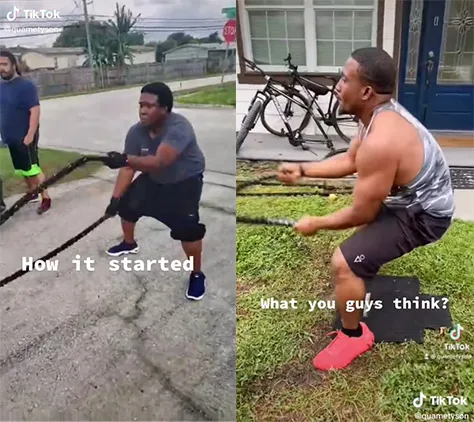
Source: @quametyson on TikTok21
Susan’s Weight Loss & Battle Ropes Transformation
Susan began her weight loss journey and utilized battle ropes alongside weightlifting and making adjustments to her diet. In the first picture, Susan weighed 330 pounds and was struggling to move the battle ropes. In the second picture, she had lost over 100 pounds and weighed 218 pounds.
She was able to quickly move the ropes and it was clear she had gained a lot of strength over time.

Source: @nzaanawellness on TikTok22

Source: @nzaanawellness on Instagram22
Battle Rope Workout Program (Heavy Rope Workout Routine)
There are a variety of different gym rope workouts that can be effective and fun to do. Battle ropes are a difficult exercise to do for a long amount of time at a lower intensity.
To achieve the best workout approaching the battle ropes from a HIIT perspective could be best.
This would be done by using the battle ropes for a short amount of time, quickly and at a high intensity then resting. HIIT exercises are a great way to build muscle and endurance so using the battle ropes in a HIIT workout would be an effective way to get some cardio in and build muscle.23
Here is a great week-long sample workout program utilizing battle ropes. This program is set for 5 days with 2 rest days.
Day 1 (Monday): Beginners Battle Rope Workout
- Alternating Waves 10 sets of 30 seconds work, 30 seconds rest in between sets.
- Kneeling Waves 10 sets of 30 seconds work, 30 seconds rest
Day 2 (Tuesday): Rest Day
Day 3 (Wednesday): Upper Body Focus
- In and Out Waves 5 sets of 30 seconds work, 30 seconds rest
- Seated Waves 5 sets of 30 seconds work, 30 seconds rest
- Kneeling Waves 5 sets of 30 seconds work, 30 seconds rest
Day 4 (Thursday): Rest Day
Day 5 (Friday): Lower Body Focus
- Alternate Single Arm Jump Squats 5 sets of 30 seconds of work, 30 seconds of rest
- Power Slams 5 sets of 30 seconds of work, 30 seconds rest
This workout program can be adjusted to make it easier or more difficult by adding additional sets or changing the amount of time of rest or work.

Source: kanchanachitkhamma via Canva.com24
Battle ropes are an effective muscle-building and cardio workout that offers a lot of variabilities to meet one’s personal needs. It is clear that with battle rope, muscles worked list is extensive and there are countless reasons why someone should add battle ropes to their workout plan.
Frequently Asked Questions
What Are the Battle Rope Muscles Worked if Only Horizontal Movements Are Done?
Horizontal movements with the battle ropes will place a larger emphasis on the upper body, specifically the lats, shoulders, biceps, triceps, and forearms. This is because of the different arm motions required to move horizontally vs vertically.
Should I Try the Battle Rope?
Battle ropes are a fantastic low-impact cardio workout that can target every muscle in the body. Because of this, battle ropes are worth a try but it is important to remember the value of finding enjoyment in physical activity, and finding an exercise you enjoy is most important for long-term success.10
Are Battle Ropes a Good Workout for Beginners?
Battle ropes can be a challenging exercise but there are a lot of modifications that can be made to make it a great exercise for beginners. Battle ropes make for effective cardio and muscle-building exercise and would be a good option for beginners because of that.
Should I Do Battle Ropes Every Day? What Would Happen?
Taking time to rest, recover, and sleep is crucial in any workout routine to help the body recover and build muscle. While it could be possible to do battle ropes every day, taking time to rest and listen to one’s body is important to create a healthy and long-term exercise routine.
How Long Should I Workout With Battle Ropes?
Battle ropes will be difficult to be performed for a long amount of time so it may be best to utilize battle ropes with a HIIT workout by working out on the battle ropes for 30 seconds and then taking a 30-second break. As muscle and endurance are built up the amount of time the exercise can be increased.
How Much Do Battle Ropes Weigh?
There are a variety of different types of battle ropes with different lengths and weights. Battle rope’s weights typically range between 16 and 27 pounds with the longer ropes weighing more than the shorter ropes.
Can Battle Ropes Build Muscle?
Battle ropes can build muscle when used by beginners, but people can also use heavier and heavier battle ropes in order to stimulate hypertrophy (build muscle) and progressively overload (increase the amount of working load) during their training program.
References
1Ridofranz. “Young man exercising using battle rope.” Canva. Accessed 15 April 2023. <https://www.canva.com/photos/MADaYutUzlU-young-man-exercising-using-battle-rope/>
2Chen, W.-H., Wu, H.-J., Lo, S.-L., Chen, H., Yang, W.-W., Haung, C.-F., & Liu, C. (2018). Eight-Week Battle Rope Training Improves Multiple Physical Fitness Dimensions and Shooting Accuracy in Collegiate Basketball Players. J Strength Cond Res. <https://pubmed.ncbi.nlm.nih.gov/29847529/>
3Tima Miroshnichenko. “A Woman Working Out with Battle Ropes.” Canva. Accessed 15 April 2023. <https://www.canva.com/photos/MAESPknjGrw-a-woman-working-out-with-battle-ropes/>
4decade3d. “Hamstrings – Anatomy Muscles.” Canva. Accessed 15 April 2023. <https://www.canva.com/photos/MADerMxdfBI-hamstrings-anatomy-muscles/>
5decade3d. “Gluteus Maximus – Anatomy Muscles.” Canva. Accessed 12 April 2023. <https://www.canva.com/photos/MADerAJvWMU-gluteus-maximus-anatomy-muscles/>
6Hank Grebe. “Male Rhomboid Major Back Muscles in Isolation on Skeleton.” Canva. Accessed 15 April 2023. <https://www.canva.com/photos/MAD9YMm5tt4-male-rhomboid-major-back-muscles-in-isolation-on-skeleton/>
7Science Photo Library. “The muscles involved in standing biceps curl. The stabilizing muscles are highlighted.” Canva. Accessed 12 April 2023. <https://www.canva.com/photos/MADmTGwAFbo-the-muscles-involved-in-standing-biceps-curl-the-stabilizing-muscles-are-highlighted-/>
8Science Photo Library. “”Human trapezius muscles.” Canva. Accessed 13 April 2023. <https://www.canva.com/photos/MADmTLHptgU--human-trapezius-muscles/>
9Hank Grebe. “Labeled Anatomy Chart of Neck and Shoulder Muscles on White Background.” Canva. Accessed 15 April 2023. <https://www.canva.com/photos/MADZASGJL7w-labeled-anatomy-chart-of-neck-and-shoulder-muscles-on-white-background/>
10Hank Grebe. “Labeled Anatomy Chart of Shoulder, Elbow and Triceps Muscles in Skeleton on Black Background.” Canva. Accessed 14 April 2023. <https://www.canva.com/photos/MAEJnzTxmJU-labeled-anatomy-chart-of-shoulder-elbow-and-triceps-muscles-in-skeleton-on-black-background/>
11decade3d. “Abs – Anatomy Muscles.” Canva. Accessed 12 April 2023. <https://www.canva.com/photos/MADerFwn3js-abs-anatomy-muscles/>
12Science Photo Library. “”Shoulder muscles.” Canva. Accessed 12 April 2023. <https://www.canva.com/photos/MADmTDg8VA4--shoulder-muscles/>
13RODNAE Productions. “Man Holding Battle Ropes.” Canva. Accessed 15 April 2023. <https://www.canva.com/photos/MAEZjPxW5XU-man-holding-battle-ropes/>
14Fountaine, C. J., & Schmidt, B. J. (2015). Metabolic cost of rope training. J Strength Cond Res. <https://pubmed.ncbi.nlm.nih.gov/23897017/>
15Gaesser, G. A., & Angadi, S. S. (2011). High-intensity interval training for health and fitness: can less be more? J Appl Physiol. <https://pubmed.ncbi.nlm.nih.gov/21979806/>
16Bornath, D. P. D., & Kenno, K. A. (2022). Physiological Responses to Increasing Battling Rope Weight During Two 3-Week High-Intensity Interval Training Programs. J Strength Cond Res. <https://pubmed.ncbi.nlm.nih.gov/32091465/>
17Ratamess, N. A., Rosenberg, J. G., Klei, S., Dougherty, B. M., Kang, J., Smith, C. R., Ross, R. E., & Faigenbaum, A. D. (2015). Comparison of the acute metabolic responses to traditional resistance, body-weight, and battling rope exercises. J Strength Cond Res. <https://pubmed.ncbi.nlm.nih.gov/24942174/>
18Horton, E. S., & Beisel, W. R. (1994). Food Components to Enhance Performance: An Evaluation of Potential Performance-Enhancing Food Components for Operational Rations. Institute of Medicine (US) Committee on Military Nutrition Research. <https://www.ncbi.nlm.nih.gov/books/NBK209038/>
19Schoenfeld, B. J., Peterson, M. D., Ogborn, D., Contreras, B., & Sonmez, G. T. (2015). Effects of Low- vs. High-Load Resistance Training on Muscle Strength and Hypertrophy in Well-Trained Men. J Strength Cond Res. <https://pubmed.ncbi.nlm.nih.gov/25853914/>
20Calatayud, J., Martin, F., Colado, J. C., Benitez, J. C., Jakobsen, M. D., & Andersen, L. L. (2015). Muscle Activity During Unilateral vs. Bilateral Battle Rope Exercises. J Strength Cond Res. <https://pubmed.ncbi.nlm.nih.gov/25853917/>
21@quametyson. TikTok. Accessed 15 April 2023. <https://www.tiktok.com/@quametyson/video/7097029726673407278?_r=1&_t=8YWAT7DtnjC&is_from_webapp=v1&item_id=7097029726673407278>
22@nzaanawellness. TikTok. Accessed 15 April 2023. <https://www.tiktok.com/@nzaanawellness/video/7077501023790615813?_r=1&_t=8YWB37ghnmV&is_from_webapp=v1&item_id=7077501023790615813>
23Atakan, M. M., Guzel, Y., Bulut, S., Kosar, S. N., McConell, G. K., & Turangol, H. H. (2021). Six high-intensity interval training sessions over 5 days increases maximal oxygen uptake, endurance capacity, and sub-maximal exercise fat oxidation as much as 6 high-intensity interval training sessions over 2 weeks. J Sport Health Sci. <https://pubmed.ncbi.nlm.nih.gov/32565243/>
24kanchanachitkhamma. “Athletic Men Doing a Fitness Workout with Battle Rope in Functio.” Canva. Accessed 15 April 2023. <https://www.canva.com/photos/MAEV6GgtGHc-athletic-men-doing-a-fitness-workout-with-battle-rope-in-functio/>